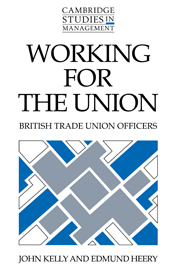Book contents
- Frontmatter
- Contents
- List of figures and tables
- Preface
- List of abbreviations
- Part 1 Introduction
- Part 2 The parameters of union work
- 3 Full-time officer organization
- 4 Employment relations
- 5 Work relations
- Part 3 The full-time officer at work
- Part 4 Conclusions
- Appendix: Research methods
- Notes
- Bibliography
- Index of names
- Index of subjects
- Cambridge Studies in Management
3 - Full-time officer organization
Published online by Cambridge University Press: 22 October 2009
- Frontmatter
- Contents
- List of figures and tables
- Preface
- List of abbreviations
- Part 1 Introduction
- Part 2 The parameters of union work
- 3 Full-time officer organization
- 4 Employment relations
- 5 Work relations
- Part 3 The full-time officer at work
- Part 4 Conclusions
- Appendix: Research methods
- Notes
- Bibliography
- Index of names
- Index of subjects
- Cambridge Studies in Management
Summary
Introduction
This chapter is concerned with the basic parameters of organization among full-time officers. It deals with officer numbers, ratios of officers to members and trends in officer employment, as well as with patterns of officer bureaucracy, the degrees of hierarchy, specialization and dispersal of officers. The aim is to describe each of these dimensions of officer organization and both to show and to account for variation in officer organization across unions. The intention is also to describe such variation over time and examine how full-time officer organization in British unions has been affected by the sustained period of union retreat and aggregate membership decline since 1979. One might hypothesize, for example, that decline would be accompanied by a shrinkage in the size of the total officer workforce, a reduction in the number of officer grades within unions, and possibly by an increase in specialization, as unions appointed recruitment and other specialists in response to the drop in membership.
In pursuing the theme of why union officers are organized as they are the group of hypotheses, claims and arguments we have labelled ‘contingency theory’ has greatest relevance. A key argument to be examined is Clegg's (1976: 8–11) contention that forms of union organization are powerfully determined by the structure of collective bargaining and by variations in the level of bargaining in particular. This would suggest that unions which are primarily engaged in industry-level bargaining, like those in the public sector, will have fewer officers, larger numbers of members per officer and more centralized, less spatially dispersed patterns of officer bureaucracy. Other contingencies, however, may also exert an influence.
- Type
- Chapter
- Information
- Working for the UnionBritish Trade Union Officers, pp. 33 - 52Publisher: Cambridge University PressPrint publication year: 1994



